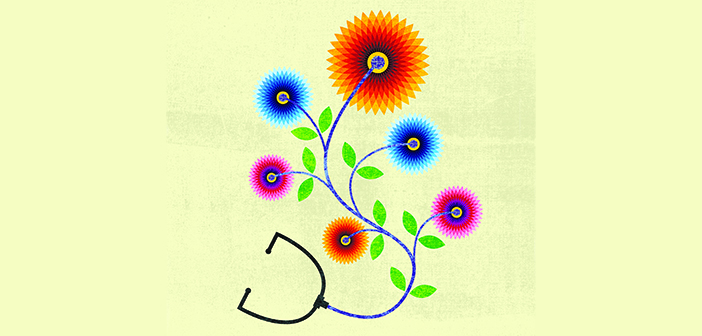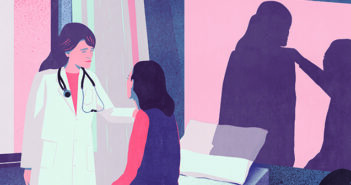Volunteering in the community helps future physicians connect more deeply with patients—and themselves.
Armed with plastic fruits and vegetables, a stethoscope, toy syringes, and boxes of Band-Aids, a half dozen classmates and I walked into a Pawtucket, RI, preschool classroom ready to teach kids about health and wellness. Using stuffed teddy bears as our patients, we discussed many topics, including germs, nutrition, and exercise. Even more important, we got to hear directly from the 3-, 4-, and 5-year-olds about their fears of seeing doctors and their excitement about being healthy.
This and other community-based experiences—all part of a new service learning initiative at the Warren Alpert Medical School—are as vital to my understanding of what it means to be a physician as learning to listen to heart sounds, treat injuries, or interpret X-rays.
Service learning, which integrates community service with traditional curricula, enables students to apply classroom lessons to the real-world needs of local communities. It also includes time for personal reflection, which can fortify a commitment to service and may even help prevent burnout. But perhaps above all, service learning allows medical students to connect with underserved communities in ways that can last a lifetime.
Research backs up the value of service learning. According to a 2014 analysis of 18 studies, service learning strengthens university-community relationships and improves students’ communication, collaboration, clinical skills, and cognitive-emotional development. What’s more, the Liaison Committee on Medical Education, the accrediting body for MD-granting programs in the US, recognizes this pedagogical approach with a specific standard on service learning.
Yet not many medical schools adopt service learning. In 2015, only 25 percent of participants in the AAMC Curriculum Inventory reported offering service learning or some other form of community service. Given the many benefits of experiential learning—and academic medicine’s increasing focus on community engagement—schools should explore ways to offer or increase service learning opportunities for their students.
The Warren Alpert Medical School unveiled its Service-Learning Project in 2018 as part of its Doctoring course, allowing second-year students to fulfill certain requirements through volunteer experiences. Previously, the community-based component of the course was limited to working in hospitals, physician groups, or private practices.
Wondering what inspired this change, I asked the assistant director of the Doctoring program, Julia Noguchi, MPH, who explained that the impetus came from students who felt a lack in the curriculum. “As one student put it,” she said, “‘I’ve practiced the cardiopulmonary exam dozens of times, but still feel like I have a lot to learn about treating LGBTQ+ patients.’ Students told us they wanted more opportunities to learn how to be competent providers for all patients.”
Noguchi’s reply harkens back to the Medical School’s mission: “the pursuit of health to benefit society.” It also reminds me why I chose Brown: my desire to attend a school that views health as a community effort and sees physicians as public servants.
COMMUNITY CONNECTIONS
In Providence, nearly 13 percent of families live below the poverty line. When it came time for me to pick my service learning project, I had my choice of more than 40 diverse organizations, ranging from those that help homeless or incarcerated individuals to one that teaches parents how to prevent childhood lead poisoning.
In addition to my stint at the preschool, I also opted to teach sex education classes in a Rhode Island middle school. But one of my most powerful experiences occurred while volunteering at the Ronald McDonald House of Providence, which provides lodging to families of children receiving treatment at local hospitals.
The facility had an intimacy that I hadn’t anticipated. My fellow students and I were walking into what had become the home of families going through an unimaginably difficult period. As we treated the families to warm food and smiling faces, the act of serving pasta and tomato sauce—a common meal for many medical students—took on a whole new meaning. That experience and similar ones have taught me that simple acts of kindness, careful listening, and direct outreach contribute immeasurably to the wellness of patients and of the wider community.
In fact, I was so struck by my experience that I wanted to know whether other students also viewed service learning as indispensable to their education.
I talked with several classmates who worked with the nonprofit Higher Ground International, educating West African immigrants about dental hygiene and mental health. One, Cleo Rochat MD’21, considered the project one of her most important experiences as a medical student. “Teaching the women at Higher Ground was an opportunity to engage with and learn from the refugee community,” she said. “I was struck by the closeness and strength of the community and how eager they were to access health resources and help their community to do the same.”
Godwin Boaful ’16 MD’21 echoed Rochat’s thoughts. “It was an exceptionally enriching experience to share information with [patients], but more importantly, to hear their own experiences,” he said. “It was equally rewarding to hear their advice on how to be better physicians.” That advice, he explained, stressed the importance of physicians focusing on patients’ concerns, rather than their own priorities.
Thanks to my service learning experience, I’m focused on becoming a doctor who goes above and beyond for my patients. I’m learning to be a doctor who thinks about the community in which my patients work, live, and play, one who focuses on how the biggest components of health and wellness are outside the four walls of the hospital. I am determined to be a physician who pursues health to benefit both my local community and all of society.




